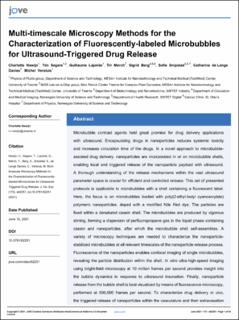| dc.contributor.author | Nawijn, Charlotte | |
| dc.contributor.author | Segers, Tim | |
| dc.contributor.author | Lajoinie, Guillaume | |
| dc.contributor.author | Mørch, Ýrr Asbjørg | |
| dc.contributor.author | Berg, Sigrid | |
| dc.contributor.author | Snipstad, Sofie | |
| dc.contributor.author | Davies, Catharina de Lange | |
| dc.contributor.author | Versluis, Michel | |
| dc.date.accessioned | 2023-07-06T10:58:38Z | |
| dc.date.available | 2023-07-06T10:58:38Z | |
| dc.date.created | 2021-08-20T08:45:19Z | |
| dc.date.issued | 2021 | |
| dc.identifier.citation | Journal of Visualized Experiments. 2021, 172, e62251. | en_US |
| dc.identifier.issn | 1940-087X | |
| dc.identifier.uri | https://hdl.handle.net/11250/3076549 | |
| dc.description.abstract | Microbubble contrast agents hold great promise for drug delivery applications with ultrasound. Encapsulating drugs in nanoparticles reduces systemic toxicity and increases circulation time of the drugs. In a novel approach to microbubble-assisted drug delivery, nanoparticles are incorporated in or on microbubble shells, enabling local and triggered release of the nanoparticle payload with ultrasound. A thorough understanding of the release mechanisms within the vast ultrasound parameter space is crucial for efficient and controlled release. This set of presented protocols is applicable to microbubbles with a shell containing a fluorescent label. Here, the focus is on microbubbles loaded with poly(2-ethyl-butyl cyanoacrylate) polymeric nanoparticles, doped with a modified Nile Red dye. The particles are fixed within a denatured casein shell. The microbubbles are produced by vigorous stirring, forming a dispersion of perfluoropropane gas in the liquid phase containing casein and nanoparticles, after which the microbubble shell self-assembles. A variety of microscopy techniques are needed to characterize the nanoparticle-stabilized microbubbles at all relevant timescales of the nanoparticle release process. Fluorescence of the nanoparticles enables confocal imaging of single microbubbles, revealing the particle distribution within the shell. In vitro ultra-high-speed imaging using bright-field microscopy at 10 million frames per second provides insight into the bubble dynamics in response to ultrasound insonation. Finally, nanoparticle release from the bubble shell is best visualized by means of fluorescence microscopy, performed at 500,000 frames per second. To characterize drug delivery in vivo, the triggered release of nanoparticles within the vasculature and their extravasation beyond the endothelial layer is studied using intravital microscopy in tumors implanted in dorsal skinfold window chambers, over a timescale of several minutes. The combination of these complementary characterization techniques provides unique insight into the behavior of microbubbles and their payload release at a range of time and length scales, both in vitro and in vivo. | en_US |
| dc.language.iso | eng | en_US |
| dc.publisher | Journal of Visualized Experiments | en_US |
| dc.rights | Attribution-NonCommercial-NoDerivatives 4.0 Internasjonal | * |
| dc.rights.uri | http://creativecommons.org/licenses/by-nc-nd/4.0/deed.no | * |
| dc.title | Multi-timescale microscopy methods for the characterization of fluorescently-labeled microbubbles for ultrasound-triggered drug release | en_US |
| dc.type | Peer reviewed | en_US |
| dc.type | Journal article | en_US |
| dc.description.version | publishedVersion | en_US |
| dc.rights.holder | © 2021 JoVE | en_US |
| dc.source.pagenumber | 24 | en_US |
| dc.source.volume | 2021 | en_US |
| dc.source.journal | Journal of Visualized Experiments | en_US |
| dc.source.issue | 172 | en_US |
| dc.identifier.doi | 10.3791/62251 | |
| dc.identifier.cristin | 1927505 | |
| dc.source.articlenumber | e62251 | en_US |
| cristin.ispublished | true | |
| cristin.fulltext | original | |
| cristin.qualitycode | 1 | |

